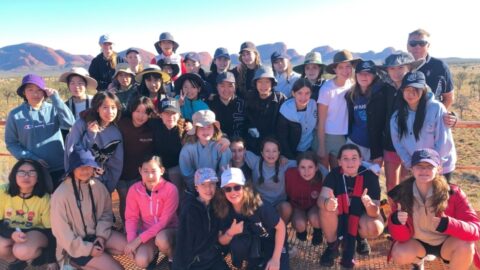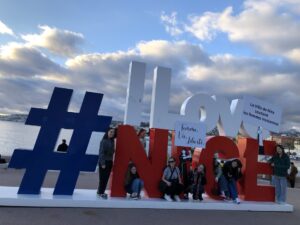Choose Your Own Adventure

Discovering your true sense of self, also known as Identity Achievement, has been found to be a predictor of psychological wellbeing. But how is it achieved? Head of Year 8, Ms Liv Cher shares current research into how the adventure of experience during adolescence and early adulthood craft our passions and interests into adulthood.
Identity achievement is “a cognitive process that refers to exploring an identity and developing an understanding of the meaning of that identity in one’s own life” (Ghavami, Fingerhut, Peplau, Grant, Wittig, 2011). It describes a stage of life where a person discovers and finds their true sense of self. This occurs in adulthood after a person has travelled through a variety of life experiences and passed through the identity development stages of adolescence. Identity achievement is a predictor of psychological wellbeing (Waterman, A.S., 2007).
What is critical to understand is that identity achievement is more than a mere end point. It is a journey that begins in childhood and is often carried through to early adulthood. The main developmental stages occur between the ages of 10 and 19. Identity achievement cannot be realised without a variety of life experiences and periods of change (Practical Psychology, 2019). Thus starts the adventure of experience, or what I like to call Choose Your Own Adventure.
Stages of life can often be compared to a book, with each chapter representing a new experience, opportunity, or challenge. Similarly, the journey of one’s education and personal growth can be likened to a “choose your own adventure” story, where the decisions made can influence character development and shape the narrative for the protagonist, as a learner and as a human being. These choices provide students with agency to choose experiences in which to develop their self-efficacy and ultimately work towards identity achievement.
Chapter 1 – Setting the Stage
Setting the stage for where the girls’ Senior School story begins, our first chapter of Years 7 and 8 involves extensive discussions on developing our identities and thinking about our legacies as members of the St Catherine’s community. These discussions take place during our weekly Wellbeing and Academic Advisory Sessions.
 Students navigate opportunities and make decisions about their commitment and participation in academic and co-curricular competitions, soirees, clubs, sports, camps, ensembles, the play, and the musical.
Students navigate opportunities and make decisions about their commitment and participation in academic and co-curricular competitions, soirees, clubs, sports, camps, ensembles, the play, and the musical.
The choices students make here can forge paths of passion, help them recognise their strengths, teach them new skills, create connections, and ensure they are recognised by their community for their outstanding talents.
It often helps them find their voice and understand the benefits of balance in learning. The broad offerings of subjects at these Year levels provide a significant context from which to understand the setting of the story; they set the stage for the next chapter.
Reading ahead in the book, moving into Year 9, the plot thickens. Looking towards the next chapter, the Year 8s find themselves discussing Subject Selections and the opportunity for growth through the extensive offerings of Global Programs. Just like in a ‘choose your own adventure’ book, these choices grant great agency, continuing to shape the narrative and influence the direction of each student’s educational journey.
Chapter 2: What are my strengths? What could my path be?
Just when we started feeling comfortable in our story, it is time to move on to the next challenge. The process of choosing subjects lays the foundation for the academic journey ahead. Just as a protagonist decides their initial path in a story, our Year 8s must select subjects that resonate with their interests, strengths, and aspirations. The choices they make here serve as the initial turning points for identity achievement, setting the tone for the chapters to come.
Similar to flipping through the pages of a book, students browse through subject pages on the portal, weighing the options before them. Will they choose subjects that align with their long-held passions or dare to venture into new territories? The decision must include their voice, and each choice leads to a unique storyline, influencing the skills they will acquire and the knowledge they will gain.
Chapter 3: Venturing into the Unknown
 The concept of an exchange program mirrors the essence of a “choose your own adventure” book in its truest form. When one decides to embark on an exchange, they are presented with a pivotal choice that has far-reaching consequences. This decision to step out of one’s comfort zone is akin to a reader selecting a daring option that propels the story into unexplored realms.
The concept of an exchange program mirrors the essence of a “choose your own adventure” book in its truest form. When one decides to embark on an exchange, they are presented with a pivotal choice that has far-reaching consequences. This decision to step out of one’s comfort zone is akin to a reader selecting a daring option that propels the story into unexplored realms.
Much like the excitement of turning to a new page in a book, going on exchange introduces students to a new setting, culture, and academic environment. As they immerse themselves in a foreign land, those on exchange face the challenges of adapting to the unknown. Their journey becomes a dynamic narrative, enriched by cultural exchanges, personal discoveries, and friendships that span the globe.
Whilst the romantic notion of eating crepes under the Eiffel Tower with a host sister might seem fabulous for some, for others, this path may not be for them yet. It is important to remember that this path remains open beyond Year 9, and there are still plenty of adventures to be had.
Chapter 4: Crafting Your Unique Ending – It Won’t All Be Sunshine and Rainbows
The adventures in this novel will be punctuated by hurdles to overcome and doors to open. Whether it is tackling a difficult assessment, joining a club, or seeking out a mentor, it is a student’s choices that determine how they navigate these moments.
 Much like a reader’s choice in a book, opting to confront challenges head-on or explore uncharted avenues demonstrates agency. These decisions mould character, fostering resilience, adaptability, and self-efficacy. Just as a character’s journey is enriched by the trials they face, a student’s learning path gains depth and meaning through the experiences they embrace.
Much like a reader’s choice in a book, opting to confront challenges head-on or explore uncharted avenues demonstrates agency. These decisions mould character, fostering resilience, adaptability, and self-efficacy. Just as a character’s journey is enriched by the trials they face, a student’s learning path gains depth and meaning through the experiences they embrace.
What is important to remember is that a “choose your own adventure” novel was designed to encourage the reader to re-read the book multiple times, to explore alternate choices and storylines. The path was only closed and finished when the reader wanted it to be.
Similarly for our students, this is a moment of discovery. There are bound to be challenges – a subject they realise is not for them, or missing home in a foreign land. This is all part of the learning adventure, and it is not a wasted decision that has led us here. It is always something to learn from, something with which to build experience and there is always an alternative path to try if it does not work out. In fact, sometimes, we are only ready for paths further afield after we have explored the roads close by.
Our students are the protagonists of this novel, and it is crucial that they have voice in the decisions behind the journey. However, it is equally important that they are supported and guided by the community around them as they strive towards identity achievement and choosing their future chapters.


